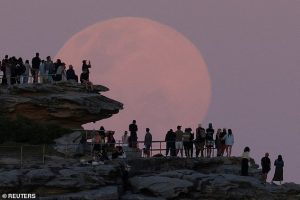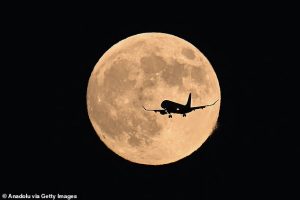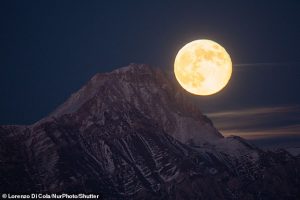Key Takeaways
- Tonight’s Beaver supermoon will appear 8% larger and 16% brighter than usual
- It will be the closest and largest supermoon of 2024 at 357,000km from Earth
- The next supermoon of this size won’t occur until November 24, 2026
- Despite cloudy forecasts, clear intervals may offer viewing opportunities
The largest supermoon of 2024 will illuminate skies worldwide tonight, offering a spectacular celestial display. This Beaver moon will appear significantly brighter and larger than usual as it reaches its closest point to Earth.
At its peak, our lunar satellite will appear eight percent larger and sixteen percent brighter than normal. The phenomenon occurs because the moon’s orbit isn’t perfectly circular around Earth, bringing it closer at certain points.
Royal Museums Greenwich advises: ‘As long as there aren’t too many clouds, the full moon will be an unmistakable white orb in the sky. This is a good opportunity to use a small telescope or a pair of binoculars to see the moon’s detailed surface.’
Viewing Conditions and Timing
Tonight, the moon will be just under 357,000km from Earth, compared to the average distance of 384,400km. This makes it the nearest full moon of the year and therefore the largest supermoon.
According to the Met Office, most of the UK will experience cloudy conditions around sunset. However, clear intervals may provide opportunities to glimpse the impressive sight. The best viewing times are just after sunset or before sunrise when the moon appears enormous against the landscape.
Why It’s Called a Beaver Moon
The first full moon of November is traditionally called a Beaver moon, dating back centuries. The term likely originated from Native American tribes and early European settlers, referencing the time when beavers become particularly active building dams and stocking food for winter.
This supermoon coincides with Bonfire Night in the UK, adding to the evening’s celestial spectacle.
Scientific Impact and Photography Tips
Supermoons slightly affect Earth’s tides due to stronger gravitational pull. Royal Museums Greenwich explains: ‘When the Moon is closer to the Earth during a supermoon, the gravitational pull is slightly stronger, and so the tides are bigger.’ However, this effect is minimal with only a couple of inches difference.
For photography enthusiasts:
- Smartphones can capture decent images when placed on steady surfaces
- SLR cameras with 250mm telephoto lenses work well
- Best detail requires 500-600mm telephoto lenses or telescopes
- Use 1/30th second shutter speeds with low ISO settings
While another supermoon occurs on December 4, the moon won’t appear this large and bright again until November 24, 2026.
Understanding Moon Terminology
Full Moon: The phase when the moon’s entire disc is illuminated during the 29.5-day lunar cycle.
Supermoon: Occurs when the full moon nearly coincides with perigee – the moon’s closest point to Earth. Supermoons appear up to 14% larger and 30% brighter than regular full moons, occurring 3-4 times yearly.
Strawberry Moon: Simply refers to June’s full moon, named for the strawberry harvest season. Each month has traditional full moon names connected to seasonal changes and nature.
Complete Full Moon Nicknames
- January: Wolf Moon
- February: Snow Moon
- March: Worm Moon
- April: Pink Moon
- May: Flower Moon
- June: Strawberry Moon
- July: Buck Moon
- August: Sturgeon Moon
- September: Corn Moon
- October: Hunter’s Moon
- November: Beaver Moon
- December: Cold Moon
Source: Old Farmer’s Almanac










